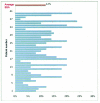Effectiveness and Patient Acceptance of Halcinonide 0.1% Cream in 216g Jars for Large-area Steroid-responsive Dermatoses
- PMID: 21532875
- PMCID: PMC3084610
Effectiveness and Patient Acceptance of Halcinonide 0.1% Cream in 216g Jars for Large-area Steroid-responsive Dermatoses
Abstract
When treating patients with extensive dermatitis, total body surface area affected must be considered when prescribing topical medication. Halcinonide 0.1% cream, a class 2 topical corticosteroid, is now available in a 216g jar. This large size is convenient and cost effective for patients with large-area dermatoses.
Objectives: The objectives of this study were to determine the efficacy and patient acceptance of halcinonide in 216g jars for the treatment of large-area dermatoses.
Design: This study was an open-label, noncomparator trial evaluating the clinical outcomes and acceptability of halcinonide in 216g jars. Halcinonide was prescribed twice daily for up to 28 days.
Measurement: Severity of dermatoses was based on investigator observations at the baseline visit and again after 28 days. Patient satisfaction was evaluated based on a questionnaire completed at the conclusion of the study.
Results: Total enrollment was 40 patients. Dermatoses affected an average of 12 percent body surface area. At baseline, all patients exhibited dermatoses rated as severe or moderate. Nearly half of patients were completely cleared or almost cleared by 28 days, with all patients noting at least some improvement. Most patients agreed that they liked the way the product spread on the skin (94.7%), and more than 80 percent found that it was neither sticky nor greasy. In more than 90 percent of cases, the investigator reported that halcinonide provided a shorter duration of therapy versus triamcinolone one-pound jars.
Conclusion: Halcinonide 0.1% cream in 216g jars is effective and convenient for patients with large-area dermatoses.
Figures







Similar articles
-
Efficacy of halcinonide cream, 0.1 percent, in the treatment of moderate and severe dermatoses.Cutis. 1981 Apr;27(4):433-5. Cutis. 1981. PMID: 7226895
-
Physician and Patient Assessment of Triamcinolone Acetonide Spray for Steroid-responsive Dermatoses.J Clin Aesthet Dermatol. 2010 May;3(5):27-31. J Clin Aesthet Dermatol. 2010. PMID: 20725566 Free PMC article.
-
Evaluation of a new halcinonide formulation in the treatment of common dermatoses.Cutis. 1982 Aug;30(2):262-6. Cutis. 1982. PMID: 7128207
-
Relative efficacy and interchangeability ofvarious clobetasol propionate vehicles in the management of steroid-responsive dermatoses.Curr Ther Res Clin Exp. 2005 May;66(3):154-71. doi: 10.1016/j.curtheres.2005.06.010. Curr Ther Res Clin Exp. 2005. PMID: 24672120 Free PMC article. Review.
-
Interventions for infantile seborrhoeic dermatitis (including cradle cap).Cochrane Database Syst Rev. 2019 Mar 4;3(3):CD011380. doi: 10.1002/14651858.CD011380.pub2. Cochrane Database Syst Rev. 2019. PMID: 30828791 Free PMC article.
References
-
- Tripodi S. Computer aided design mapping for SCORAD index in atopic dermatitis: ScoradCard software. Pediatr Allergy Immunol. 2005;16(2):182–183. - PubMed
-
- Zeichner JA, Lebwohl MG, Menter A, et al. Optimizing topical therapies for treating psoriasis: a consensus conference. Cutis. 2010;86(Suppl 3):5–31. - PubMed
-
- Halog® [package insert] Princeton, NJ: Ranbaxy Laboratories, Inc; 2009.
LinkOut - more resources
Full Text Sources
